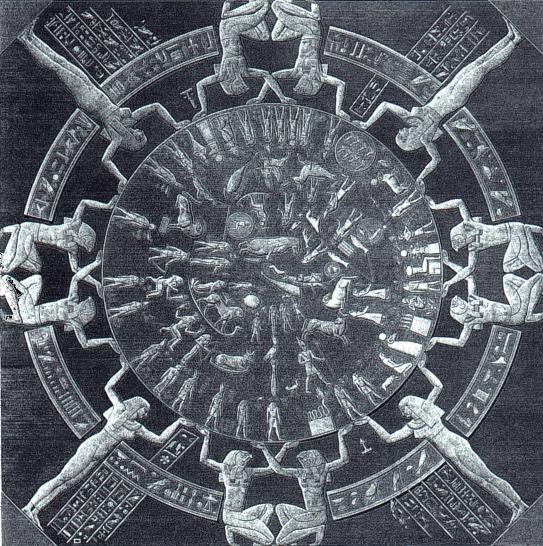
Embedded in the ceiling of a small room in the Egyptian antiquities section of the Louvre, Paris, are two huge sandstone blocks. Cut into them is a dramatic circular pattern of figures and hieroglyphs - the Dendera zodiac.
I've reviewed a book about this fascinating bas-relief in today's New Scientist. The Zodiac of Paris, by historian Jed Buchwald and writing professor Diane Greco Josefowicz, discusses the stormy debate triggered when the zodiac was first discovered in 1790 by French scientists attached to Napoleon's campaign in Egypt.
The zodiac's original home was the ceiling of an ancient temple near the village of Dendera, on the west bank of the Nile. It was taken to France in 1821 by engineer Jean Lelorrain - the book has a vivid description of his epic if politically incorrect expedition. He used gunpowder to blast the blocks from their original home, before using a sledge on rollers to drag them to the Nile (it took 16 days to cover the 4 miles). The river was at its lowest ebb so he also had to build a 60-foot earth ramp to slide the stones down to the water's edge, not to mention the fact that the boat he was trying to load them onto nearly sank under the weight.
The book focuses, however, on efforts of scientists and intellectuals of the time to date the zodiac. Scientists believed that the zodiac, along with three others found - one more at Dendera and two at Esneh - was intended to represent the state of the sky when it was produced. By deciphering the symbols, therefore, they could match up the zodiac to a particular date and work out how old the temple was. Each scholar seemed to have his own method of interpreting the symbols but most believed they were thousands of years old, perhaps dating to as far back as 15,000 BC.
All this went down extremely badly with religious conservatives, as according to the Bible the world itself was only six thousand years old, and humanity had been all but destroyed in a catastrophic flood in around 2000 BC. As the book's blurb says, the resulting row wasn't just about the zodiac, but "the merits of scientific calculation as a source of knowledge about the past". With today's arguments over intelligent design, it's a useful reminder that clashes between scientists and religious fundamentalists over the validity of different sources of knowledge are nothing new.
The book ends with the young Egyptologist Jean-Francois Champollion, best known for deciphering hieroglypics, who concluded in the early 19th century that the astronomical symbols in the zodiac formed part of a text, not an image of a sky, and dated it (much less controversially) to Roman times.
What really interests me about the zodiac, however, is what we know now about how old it is, and what the design represents - something that Buchwald and Josefowicz don't address. So I dug around a little bit and the latest interpretation is that it dates from around 50 BC. The key is an empty cartouche on a part of the temple's ceiling that was left in Egypt. A cartouche is a hieroglyph that looks like a little box and usually it would contain the name of the current ruler. Because it's empty, historians think the temple was built during the gap between death of Cleopatra's father, Ptolemy Auletes, in 51 BC, and the establishment of joint rule between Cleopatra and Caesarion (her 5-year-old son by Julius Caesar), in 42 BC.
Sylvie Cauville of the Centre for Computer-aided Egyptological Research (CCER) based at Utrecht University is the latest scholar to tackle the zodiac itself. She believes that does represent a map of the sky after all.
According to the summary on the Louvre website: "The vault of heaven is represented by a disc, held up by four women assisted by falcon-headed spirits. Thirty-six spirits or "decans" around the circumference symbolise the 360 days of the Egyptian year. The constellations shown inside the circle include the signs of the zodiac, most of which are represented almost as they are today. Aries, Taurus, Scorpion and Capricorn, for example, are easily recognisable, whereas others correspond to a more Egyptian iconography: Aquarius is represented as Hapy, the god of the Nile flood, pouring water from two vases."
Cauville has identified the symbols for the five planets known at the time, and says they are located on the map within certain signs of the zodiac. For example Venus is behind Aquarius, Jupiter is near Cancer, Mars is directly above Capricorn. This particular configuration of the planets among the constellations only happens about once every thousand years, and it occurred between 15 June and 15 August in the year 50 BC - matching perfectly the date suggested by the empty cartouche.
One lovely detail is that the map shows two eclipses, in the part of the sky where they would have been seen. Again from the Louvre website: "The solar eclipse of 7 March 51 is depicted as the goddess Isis holding a baboon (the god Thoth) by its tail, signifying her attempt to stop the moon from hiding the sun. The lunar eclipse of 25 September 52 is represented by an udjat-eye (the "whole one") because a lunar eclipse only occurs when the moon is full."
I'm still intrigued by why the Egyptians would have wanted to represent the sky at this particular point in time. The chapel that originally held the the bas-relief was intended to celebrate the resurrection of the god Osiris, so perhaps that's a clue. If I find out I'll post again...
UPDATE:
See my follow-up post on this here.